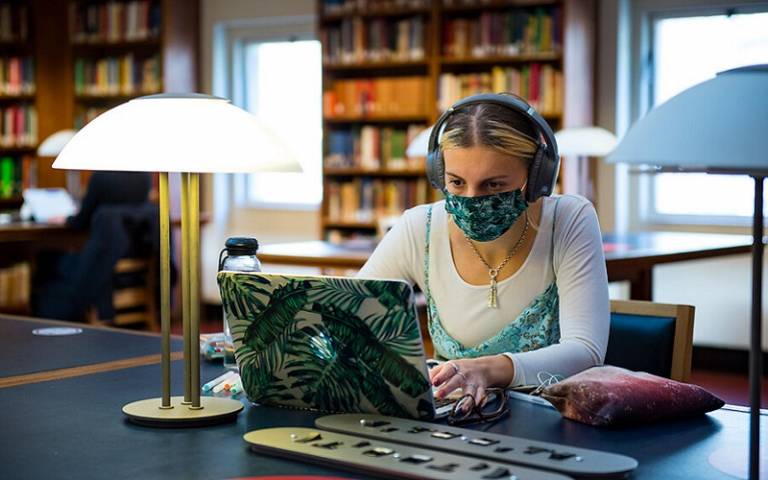Moving a Master's module online
Gemma Moore (Bartlett Institute for Environmental Design and Engineering) reflects on translating a Master’s module involving community engaged learning from a face-to-face to online format.

19 August 2021
Gemma Moore, module tutor in the Bartlett Institute for Environmental Design and Engineering, describes her experience of moving a module online during the pandemic, without compromising on student participation, experiential learning and inclusivity. She shares her top tips for staff rethinking face-to-face content for remote teaching.
Only got a minute? Jump straight to Gemma’s top 5 tips for moving your module online.
About the module
I have led the MSc module Health and Wellbeing in Cities: Theory and Practice since 2017/18. In response to COVID-19, this year I had to re-design the module for online delivery during Term 2, January 2020 – April 2020.
The module is part of the MSc Health Wellbeing and Sustainable Buildings, and explores how the built environment (in terms of planning and design) can impact upon our health. Participation, experiential learning and inclusivity are the key values underpinning the module.
As my background is in participation and engagement, I designed the module to ensure a strong community engaged learning thread was present throughout:
- The coursework: The coursework assessment is based on a real-life project. The students undertake a Health Impact Assessment (HIA) on a proposed development, and as part of the HIA process, there are two points where the students are able to get ‘outsiders’ perspectives on their work: a community workshop (with those impacted upon by the development) and presentations to panel of professionals from the field of health and planning.
- Lectures: The module is designed to include different "voices" in the lectures. For example, the lecture on the role of social networks on health is held in a community centre near the university. The format is a lecture, after which we sit and play dominos and hear from community development workers who are running initiatives to tackle loneliness etc.
- Concepts/theories: Students are encouraged to learn about the concepts of community engagement and encouraged to understand how theories are linked to the topics explored, such as community based models to health and the co-design of open spaces
Many of these community engaged learning interactions were place-based and face-to-face, so they needed rethinking with the shift to online learning during the pandemic. Despite these challenges, I was keen to ensure that the key values that underpin this approach were retained.
My priorities when moving online
1. Involve students in the preparation
Planning and preparation were vital. I met the students individually, prior to teaching starting, and explained the format and the values of the module – particularly how the synchronous sessions were going to be participatory, the opportunities for interaction and a spaces for discussion and sharing. The one-to-one contact was helpful to connect to the students on an individual level, rather than going into a session full of faces on screens. It also helped me to find out more about their disciplinary interests and where they were located.
2. Set tasks students can adapt for their own context
A live/synchronous session each week was based on an individual task I had given out the week before. These sessions also had pre-recorded materials and resources.
The tasks worked well and capitalized on the fact the students were located in different places. The sessions were made richer by creating tasks and activities that would encourage students to go out where they are, and look around to collect data or find out more. For instance, on the lecture of sound and noise in the city and health, the students were asked to download an app called Hush City, monitor their local environment and come back and share.
An indirect consequence of the task was that the materials coming out of the sessions were produced by the students – which I found personally motivating. Each task had an element of creation, which could be shared afterwards. For instance, the students’ work for the session on food/open space led to the subsequent creation of three issues of a magazine that captured their work.
3. Rethink the formative feedback approach
For the coursework assessment, I decided to keep the two opportunities for formative feedback but adjusted how these were delivered.
For the community workshop, representatives from the community presented to the students and answered questions, rather than the usual dialogue-based event. The “community” had the dominant voice and could give their perspective on the coursework case study.
The student presentations to a panel of professionals were moved online, followed by a Q&A attended by the whole class. Students fed back that an unintended outcome of our change in approach was that they enjoyed hearing how their peers in different groups had approached their coursework.
4. Learn from colleagues
The planning and delivery of the module was a collaborative effort involving partners, contributors, a Postgraduate Teaching Assistant and guests – both internal and external to UCL. Each lecture or session involved someone else, and mini-teams were created for the delivery of each session.
I spoke to lots of colleagues who ran online modules in the prior term; their experiences, achievements and challenges were very useful to helping me rethink the module in the online format.
Feedback
I received positive feedback from students and staff about the delivery of the module, including:
I’ve taken a lesson from this about doing tasks more often in my teaching … I’m having a whole rethink about the mode of teaching and intend to do more activities, which is something I’ve picked up from you - Staff member contributing to the module.
Term 2 was incredibly challenging on many levels, particularly because of the lockdown. I have so much appreciation for the way you ran the course, it was a space of calm as well as learning – Student on the module.
 Close
Close

